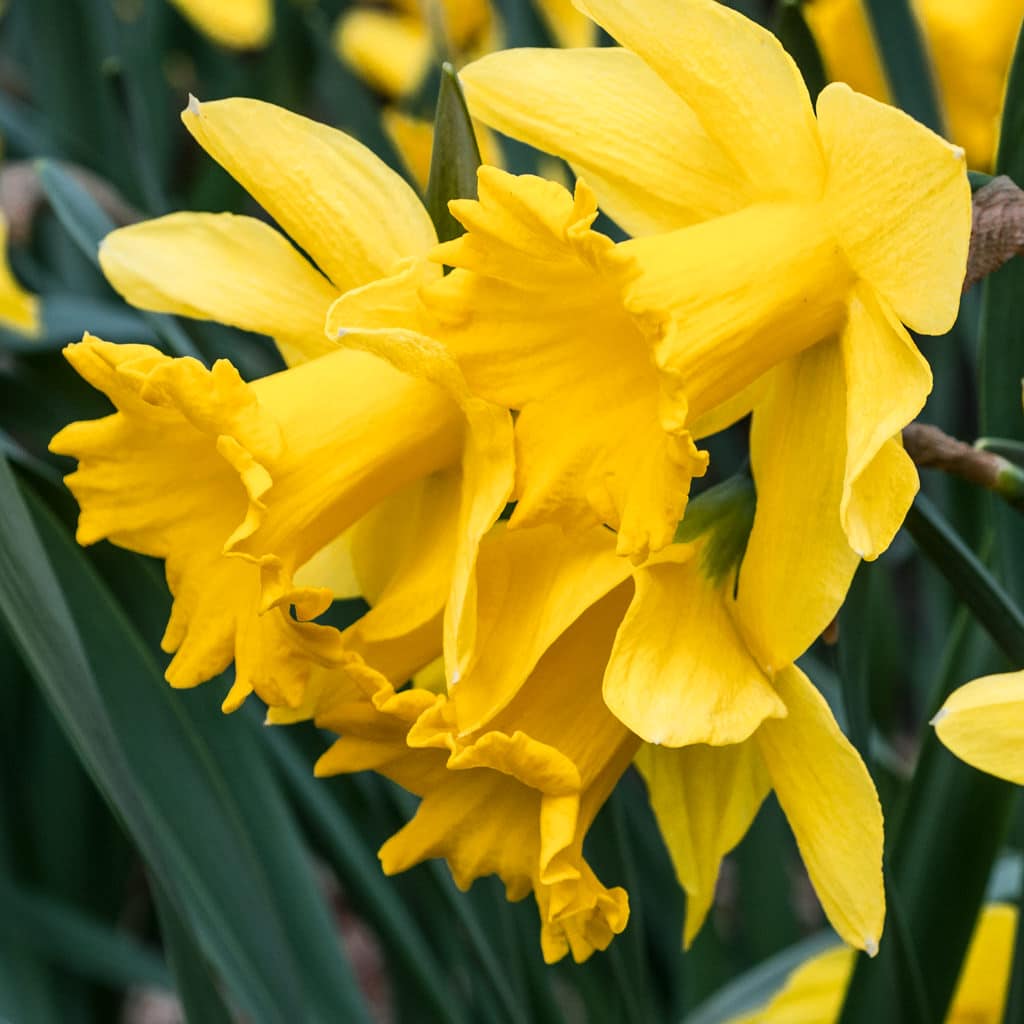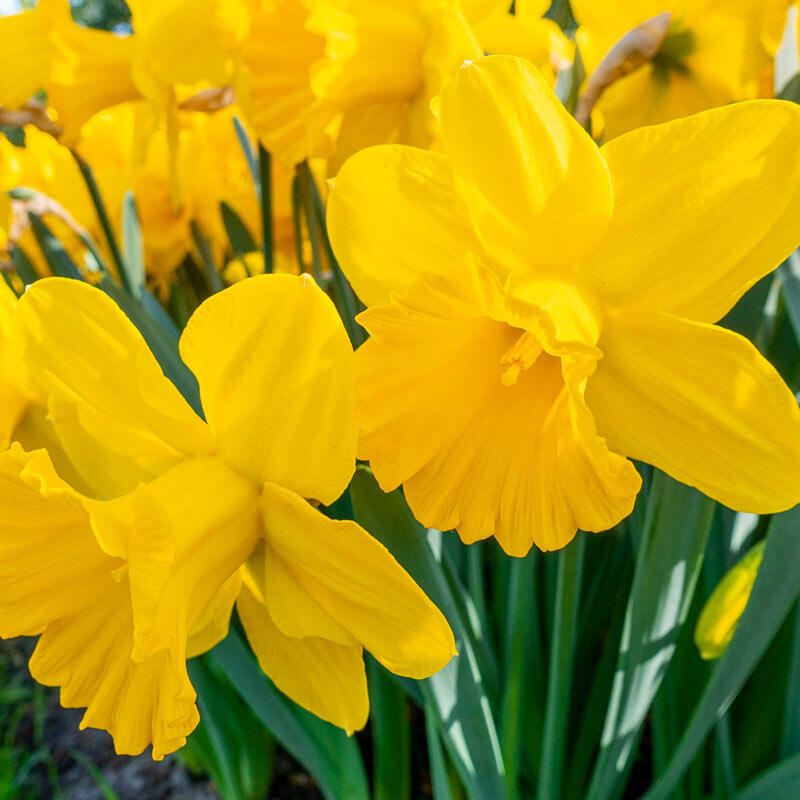To harvest daffodil bulbs, gently lift them from the ground after the foliage has turned yellow and dried. Daffodils are beautiful springtime flowers that can brighten up any garden or landscape.
However, if you want to preserve these bulbs for future use or replanting, knowing how to harvest them properly is essential. The process is fairly simple but requires timing and careful handling to ensure success. We will provide you with a step-by-step guide on how to harvest daffodil bulbs effectively.
By following these instructions, you’ll be able to dig up your daffodils without causing any damage and store them for the next growing season. Whether you’re a seasoned gardener or a beginner, this information will help you make the most of your daffodils and enjoy their beauty year after year.

Credit: www.colorblends.com
Choosing The Right Time To Harvest Daffodil Bulbs
Harvesting daffodil bulbs at the right time is crucial for their health and success in the garden. Timing the harvest requires careful consideration of several factors. One important factor to consider is the stage of development of the bulbs. When the foliage of the daffodils starts to turn yellow and dry out, it is generally a good indication that the bulbs are ready for harvesting.
Another factor to consider is the weather conditions. It is recommended to harvest the bulbs when there has been a period of dry weather, as this allows the bulbs to dry out and cure properly. Additionally, for best results, it is advisable to harvest the bulbs in the morning when the soil is still slightly moist. This makes it easier to dig up the bulbs without causing damage. By paying attention to these factors, you can ensure a successful harvest of daffodil bulbs.
| Factors to consider for timing the harvest: |
|---|
| – Stage of development of the bulbs (yellowing foliage) |
| – Weather conditions (dry period) |
| – Time of day (morning with slightly moist soil) |
Harvesting daffodil bulbs requires careful observation of signs that indicate their readiness. Yellowing foliage is a clear indication that the bulbs have reached maturity and are ready to be harvested. This typically occurs after the daffodils have finished blooming. The weather also plays a role in the timing of the harvest. It is best to wait for a period of dry weather before digging up the bulbs.
This allows the bulbs to dry out and cure properly, reducing the risk of rot. Finally, consider the time of day when harvesting. The morning, when the soil is slightly moist, is an ideal time as it makes it easier to gently dig up the bulbs without causing damage. By considering these factors and paying close attention to the signs of readiness, you can ensure a successful harvest of daffodil bulbs.
Preparing The Tools And Equipment For Harvesting
When it comes to harvesting daffodil bulbs, it is important to prepare the right tools and equipment. There are a few essential tools that you will need for a successful harvest. These include a sharp garden knife or trowel, a garden fork, a spade, and a bucket or container for collecting the bulbs. Make sure to choose tools that are in good condition and suitable for the task.
Before using the tools, it is important to clean and sterilize them to prevent the spread of diseases or pests. Cleaning the tools can be done by removing any dirt or debris and washing them with soap and water. Sterilizing the tools can be achieved by using a disinfectant solution or by soaking them in a mixture of bleach and water.
Step-by-step Guide For Harvesting Daffodil Bulbs
To harvest daffodil bulbs successfully, you need to follow a step-by-step process. Before you start, identify the bulb clumps that are ready for harvesting. Look for clumps that have finished flowering and have yellowing leaves. Once identified, proceed to dig up the bulbs, making sure to do so carefully to avoid any damage.
After digging, it’s time to separate the bulbs from the clumps. Gently remove the soil and separate any connected bulbs by hand. Be cautious not to break or bruise the bulbs during this process. Once all bulbs are separated, inspect them thoroughly for any signs of disease or damage. Remove any bulbs that may be compromised to prevent spreading to healthy ones.
Lastly, clean the harvested bulbs to remove excess soil and debris. You can rinse them with water or gently brush off the dirt. Once cleaned, allow the bulbs to air dry before storing them in a cool, dry place. Properly storing the bulbs will ensure their longevity and allow you to replant them when the time is right.
Curing And Drying The Harvested Daffodil Bulbs
To ensure the longevity and quality of your harvested daffodil bulbs, it is important to properly cure and dry them. This process involves preparing a suitable drying area and laying out the bulbs for optimal air circulation. Here are a few steps to follow:
| Step 1: | Choose a well-ventilated area such as a garage, shed, or porch to serve as your drying space. |
| Step 2: | Spread a layer of newspaper or cardboard on a flat surface within the drying area to protect the bulbs. |
| Step 3: | Gently remove any excess soil from the bulbs, taking care not to damage them. |
| Step 4: | Arrange the bulbs in a single layer on the prepared surface, ensuring that they are not touching. |
| Step 5: | Allow the bulbs to air dry in the drying area for about two weeks, monitoring them regularly. |
| Step 6: | During the drying process, remove any bulbs that show signs of damage or rot. |
This simple yet vital procedure will help preserve the quality and readiness of your daffodil bulbs for future planting.
Storing The Harvested Daffodil Bulbs For Future Use
Choosing the right storage containers for harvested daffodil bulbs is essential to maintain their quality and viability for future use. Opt for containers that have ventilation holes or slots to allow air circulation. This will prevent moisture build-up and reduce the risk of bulb rot. Additionally, choose containers made of non-reactive materials such as plastic or wood, as these will not react with the bulbs and affect their condition. It is also important to prepare the bulbs before storing them for long-term storage.
This involves removing any excess soil and foliage, as well as inspecting the bulbs for any signs of damage or disease. Discard any bulbs that appear unhealthy or compromised. Once the bulbs are prepared, store them in a cool and dark location, such as a basement or cellar, at a temperature of around 35 to 45°F (2 to 7°C) and a relative humidity of 50-60%. By providing the ideal storage conditions, you can ensure that your harvested daffodil bulbs remain in optimal condition and are ready for planting when the time comes.
Tips For Maintaining Healthy Bulbs For Next Season
Inspecting the bulbs periodically for signs of disease or damage: Regularly check your daffodil bulbs while they are in storage. Look for any signs of disease, such as soft spots, mold, or rot. If you notice any bulbs that are damaged or infected, remove them immediately to prevent the spread of disease.
Cleaning and disinfecting the storage containers: Before storing your daffodil bulbs, make sure the containers you use are clean and free of any dirt or debris. Wash them with mild soap and water, and then sanitize them with a diluted bleach solution to kill any bacteria or fungi. This will help ensure a clean environment for the bulbs during storage.
Optimizing growing conditions to promote bulb health: Provide the ideal conditions for your daffodil bulbs to thrive. This includes planting them in well-draining soil, providing adequate sunlight and water, and maintaining proper spacing between bulbs to prevent overcrowding. By optimizing these growing conditions, you can help promote the health and vitality of your bulbs for the next season.
Utilizing The Harvested Daffodil Bulbs In The Garden
When it comes to harvesting daffodil bulbs, there are various ways in which you can utilize them in your garden. One option is to replant the bulbs for next season’s growth. This ensures that you have a continuous supply of beautiful daffodils in your garden year after year.
Another option is to share or sell the excess bulbs that you have harvested. This not only allows you to spread the beauty of daffodils to others but also gives you the opportunity to earn some money.
Additionally, there are creative ways to use daffodil bulbs in flower arrangements or crafts. You can incorporate them into stunning floral displays or create unique and charming crafts using daffodil bulbs as a centerpiece.
In conclusion, harvesting daffodil bulbs opens up a world of possibilities in terms of utilizing them in your garden and beyond. Whether you choose to replant them, share or sell them, or explore their creative potential, daffodil bulbs are a versatile and beautiful addition to any garden.
Frequently Asked Questions On How To Harvest Daffodil Bulbs
How Do I Harvest Daffodil Bulbs Without Damaging Them?
To harvest daffodil bulbs without damaging them, gently loosen the soil around the bulbs using a garden fork. Carefully lift the bulbs from the ground, ensuring that the foliage remains intact. Clean off any excess dirt and allow them to dry in a cool, dry place before storing or planting.
When Is The Best Time To Harvest Daffodil Bulbs?
The best time to harvest daffodil bulbs is after their foliage has turned yellow or brown. This usually occurs in late spring or early summer. Harvesting too early can result in underdeveloped bulbs, while waiting too long may cause the bulbs to deteriorate or rot.
Can I Replant Daffodil Bulbs Immediately After Harvesting?
It is recommended to allow daffodil bulbs to dry for a few days before replanting them. This allows any excess moisture to evaporate and reduces the risk of fungal infections. Once the bulbs are dry, you can replant them in a well-prepared area with good drainage.
How Should I Store Harvested Daffodil Bulbs?
After harvesting daffodil bulbs, remove any loose soil and place them in a well-ventilated container or mesh bag. Store them in a cool, dry location, away from direct sunlight. It’s important to check the bulbs regularly for signs of disease or rot and discard any damaged or unhealthy bulbs.
Conclusion
To wrap up, harvesting daffodil bulbs is a straightforward process that can bring joy and beauty to your garden. By following these simple steps, you can ensure a successful harvest and a bountiful display of daffodils year after year. Remember to keep the bulbs dry, store them properly, and replant them at the right time.
With a little patience and care, your daffodil bulbs will reward you with vibrant blooms and a touch of springtime enchantment. Happy gardening!

